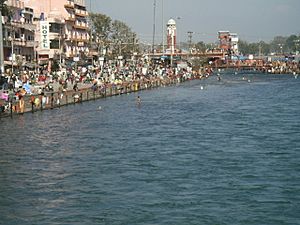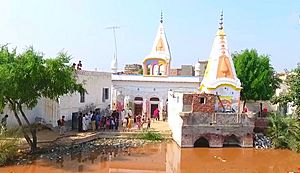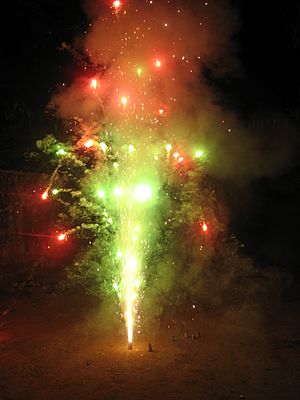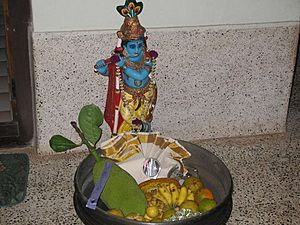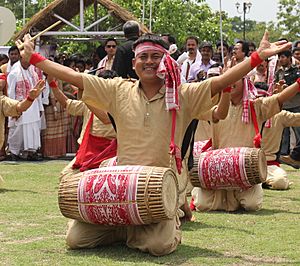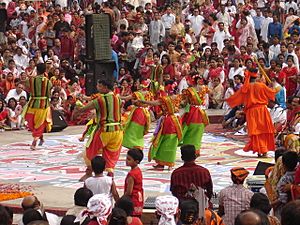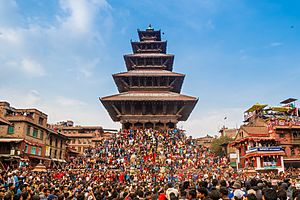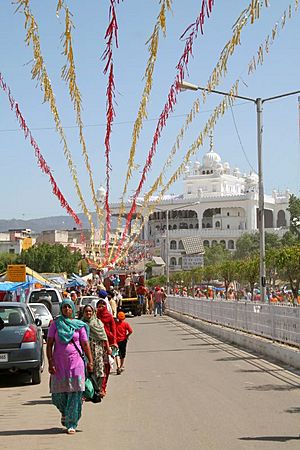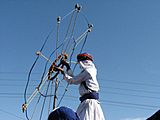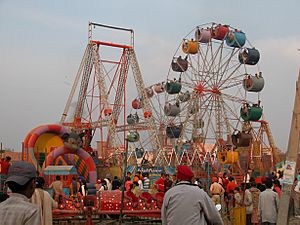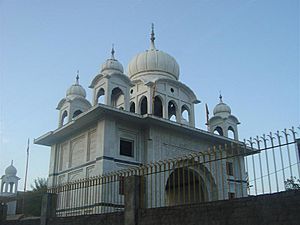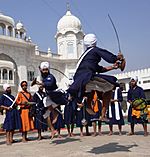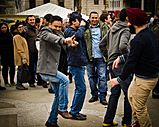Vaisakhi facts for kids
Quick facts for kids Vaisakhi |
|
|---|---|
|
Hindu religious gathering, Haridwar, Uttarakhand, India
Annual vaisakhi Fair of Dogras in Udhampur of Jammu and Kashmir.
Sikh procession in Birmingham, England
|
|
| Official name | Vaisakhi |
| Also called | Baisakhi, Visakhī |
| Observed by | Dogras, Sikhs, Punjabi Hindus, North Indians |
| Type | Religious and harvest festival |
| Significance | Solar new year, harvest festival, Initiation of Dogra/Shastri Calendar, birth of the Khalsa |
| Celebrations | Fairs and processions, temple decorations |
| Observances | Religious gatherings and practices |
| Begins | 1 Vaisakh (13 April) |
| Ends | 2 Vaisakh (14 April) |
| Date | 13 April |
| 2022 date | Wednesday, 14 April |
| First time | 5297 years ago on first day of Vaisakh month |
| Started by | Raja Shaktikaran Dogra |
| Related to | South and Southeast Asian solar New Year |
Vaisakhi, also called Baisakhi, is a special festival celebrated every year around April 13th or 14th. It marks the start of the month of Vaisakh. This festival is a big celebration of the spring harvest, especially in Northern India. People in other parts of India and around the world also celebrate Vaisakhi.
Besides being a harvest festival, Vaisakhi is also the start of the Indian Solar New Year for many. Long ago, a ruler named Raja Shaktikaran Dogra began the Shastri Calendar on this day. This makes Vaisakhi very important for the Dogra people.
For Sikhs, Vaisakhi is a huge religious festival. They hold special prayers called kirtans and visit their temples, known as Gurdwaras. There are community fairs and parades called nagar kirtan. Sikhs also raise their holy flag, the Nishan Sahib. They gather to socialize and share festive foods. Vaisakhi is especially important because it marks the birth of the Khalsa order. This was created by Guru Gobind Singh, the tenth Guru of Sikhism, on April 13, 1699. Later, Ranjit Singh became the Maharaja of the Sikh Empire on April 12, 1801, which was close to Vaisakhi. This created a united Sikh state. Vaisakhi was also the day of the Jallianwala Bagh massacre. This event was very important for India's fight for independence.
Hindus also call this day the Vaisakhi Festival. It has different names in other parts of India. Many Hindu groups bathe in holy rivers like the Ganges and visit temples. They meet friends, enjoy festivities, and give to charity. Community fairs are held at Hindu holy places. Sometimes, statues of temple gods are carried in parades. Vaisakhi started as a harvest festival for Hindus. Over time, it also became linked to Sikh history.
Contents
- When is Vaisakhi Celebrated?
- What Does Vaisakhi Mean?
- How Hindus Celebrate Vaisakhi
- Hindu Celebrations in Other Countries
- How Sikhs Celebrate Vaisakhi
- Sikh Celebrations Outside India
- Vaisakhi as a Harvest Festival
- Images for kids
- See also
When is Vaisakhi Celebrated?
Vaisakhi is usually celebrated on April 13th or 14th each year. The date can change slightly over time. For example, in 1801, it was on April 11th. This is because the date of Vaisakhi and other similar festivals slowly shifts. By the year 2999, Vaisakhi will fall on April 29th. This festival happens at the same time as other New Year celebrations. These include Pohela Boishakh, Bohag Bihu, Vishu, and Puthandu.
What Does Vaisakhi Mean?
The name Vaisakhi or Baisakhi comes from the Indian month of Vaishakha. In some older languages, the 'sh' and 's' sounds, and 'v' and 'b' sounds, were not very different. That's why you hear both Vaisakhi and Baisakhi. In languages like Bengali, it's pronounced 'Boishakhi'. Vaisakhi means 'related to the Vaisakh month'. This month is named after a star group called Vishakha. In the Punjab region, Vaisakhi is common. But in Dogra areas, people often say Baisakhi or Basoa. The spelling used to depend on the region.
How Hindus Celebrate Vaisakhi
For some Hindus, the first day of Vaisakh marks the traditional solar new year. This is true in Assam, Bengal, Bihar, Himachal Pradesh, Haryana, Kerala, Odisha, Punjab, Tamil Nadu, Uttar Pradesh, and Uttrakhand. However, not all Hindus celebrate their new year on this day. Some celebrate it during the Diwali festival. Others celebrate it a few weeks earlier with festivals like Cheti Chand, Gudi Padwa, and Ugadi.
Vaisakhi is a time of plenty for farmers. The harvest is finished, and crops are ready to sell. Fairs and special thanksgiving prayers called pujas are common. Hindus believe that the river goddess Ganga came to Earth on Vaisakhi. So, many bathe in sacred rivers like the Ganges, Jhelum, and Kaveri. They visit temples, meet friends, and enjoy festive foods.
Vaisakhi in Haridwar, Uttarakhand
Hindus believe that River Goddess Ganga came down from heaven on Vaisakhi. One of India's biggest Vaisakhi fairs is held in Haridwar. This is an important Hindu pilgrimage site. About 5 million pilgrims go to Brahm Kund in Haridwar. They take a dip in the Ganga river during the festival.
Vaisakhi in Punjab
In the past, the Hindu Shrine of Katas Raj in Undivided Punjab was famous for its Vaisakhi fair. About 10,000 pilgrims, mostly Hindus, attended it. Similarly, at the shrine of Bairagi Baba Ram Thaman, a Vaisakhi fair has been held every year since the 16th century. About 60,000 pilgrims and holy men from all over India would visit this shrine.
The biggest Vaisakhi gathering is at Thakurdwara of Bhagwan Narainji. This is in Pandori Mahatan village in Gurdaspur district of Punjab. The fair lasts for three days. Celebrations begin with a procession carrying the Mahant (religious leader) in a palanquin. Then, a Navgraha Puja is held. People give money, grains, and cows to charity. In the evening, Sankirtan (religious singing) takes place. The Mahant gives religious talks and shares prasad (blessed food). Pilgrims also bathe in the sacred tank at the shrine.
Vaisakhi in Jammu
Vaisakhi is a key festival for Dogra Hindus in the Jammu area. On this day, people wake up early. They go to rivers, canals, and ponds for a ritual bath. In Dogra homes, a Puja is performed. Part of the food harvest is offered to the gods. People also enjoy the first fruits of the year. Bathing in the Tawi river during Vaisakhi is common in Jammu.
Vaisakhi is celebrated in Udhampur by the Devika river. For three days, people enjoy folk songs. In Sudhmahadev, this festival is celebrated with great excitement. Folk singers perform, and there's a folk song competition. Vendors set up shops and food stalls.
Many visit the Nagbani temple for the New Year celebration. Vaisakhi is also a "harvest festival" and is seen as a good time for marriages. Celebrations include Dogri Bhangra dancing. Bhangra is a dance from Punjab and is more for fun than religion.
Many fairs are held, and thousands of people come to celebrate Vaisakhi. For example, Airwan in Kathua has a Vaisakhi fair with 10,000 people. Every year, about 15,000 pilgrims visit the 700-year-old Subar Nag Devta temple in Bhaderwah. Other places with Vaisakhi fairs include Doda Bridge and Ramban.
Vaisakhi in Himachal Pradesh
In Himachal Pradesh, Vaisakhi is an important Hindu festival. People wake up early and take a ritual bath. They light two earthen lamps: one with oil and one with Ghee. These are placed in a large dish with water, green grass, Kusha, Incense, Sandal, Vermillion, and money. They use these items to worship household gods.
Alms (donations) of rice and pulses with small coins are given. This is called Nasrawan and is usually given to the family priest. Fried black gram cakes, made the day before, are shared with neighbors after the Puja. Special dishes are prepared. Houses are whitewashed and floors plastered, which is called Prau lagana. In the evening, people enjoy fairs that last for three days.
Vaisakhi in Haryana
Vaisakhi is celebrated with religious passion in Yamunanagar and Kurukshetra. In Kurukshetra district, a Vaisakhi fair is held at Baan Ganga Tirtha. This place is linked to Arjuna from the Mahabharata. There is a Vaisakhi tradition of ritual bathing at the sacred tank of Baan Ganga Tirtha in Dayalpur village. The Haryana government also holds a Vaisakhi festival in Pinjore Garden.
Vaisakhi in Uttar Pradesh
Vaisakhi, or Vaisakhi Sankranti, is celebrated on the first day of Vaisakha. This is according to the Hindu Solar Calendar. This day is also known as Sattuā or Satwahi. This is because Sattu (a type of flour) is given and eaten on this day. Common traditions include bathing in a river or pond. People also eat Sattu and Gur (Jaggery).
Other Hindu Solar New Years
Vaisakhi happens on the first day of the solar year. This is the solar New Year or Mesha Sankranti. It is linked to other regional new years like 'Vishu' and 'Puthandu'. These are celebrated in Kerala and Tamil Nadu a day after Vaisakhi. The celebrations include fireworks, buying new clothes, and special displays called 'Vishu Kani'. Hindus arrange flowers, grains, and fruits. Friends and family visit to see these as a "lucky sight" (Vishukkani). Giving gifts and helping those in need are traditions in Kerala on this day. Vaisakhi is also linked to Bohag (Rongali) Bihu in Assam and Pohela Boishakh in Bengal. These are usually one or two days after Vaisakhi.
Here are some other New Year festivals:
- Bohag Bihu in Assam, India
- Pohela Boishakh in West Bengal, India and Bangladesh
- Pana Sankranti (Maha Vishuba Sankranti) in Odisha, India
- Jur Sital in Mithila (Bihar, India and parts of Nepal)
- Bwisagu in Bodoland region of Assam, India
- Bisu in Tulu Nadu region of Karnataka, India
- Puthandu in Tamil Nadu, India and parts of Sri Lanka
- Vishu in Kerala, India
Vishu Celebrations
Vishu is a Hindu festival celebrated on the same day as Vaisakhi in Kerala, India. It falls on the first day of the Malayali month called Medam. This festival is known for being calm and simple. It does not have the grand shows of other Kerala Hindu festivals like Onam.
Families spend time together and prepare colorful, lucky items. They view these as the first thing on Vishu day. Malayali Hindus especially like to see the golden flowers of the Indian laburnum (Kani Konna). They also look at money or silver items (Vishukkaineetam) and rice. Children play with fireworks. People wear new clothes (Puthukodi) and eat a special meal called Sadya. This meal has a mix of salty, sweet, sour, and bitter foods. The Vishu setup often includes a picture of Vishnu, usually as Krishna. People also visit temples on this day.
Bohag Bihu Celebrations
Bohag Bihu, or Rangali Bihu, marks the start of the Assamese New Year on April 13th. It is celebrated for seven days. This happens during the Vishuva Sankranti (Mesha Sankranti) of the Vaisakh month, or 'Bohag'. There are three main types of Bihu. Each festival is historically linked to a different farming stage of rice crops. During Rangali Bihu, there are seven main phases. These are 'Chot', 'Raati', 'Goru', 'Manuh', 'Kutum', 'Mela', and 'Chera'.
Maha Vishuba Sankranti Celebrations
Pana Sankranti (ପଣା ସଂକ୍ରାନ୍ତି), also called Maha Vishuba Sankranti, marks the Odia new year in Odisha. Celebrations include different folk and classical dances. One example is the Chhau dance, which is linked to Shiva. On this day, people hang Neem branches with leaves in front of their homes. They believe this brings health benefits. They make a liquid mix of jaggery, mango, pepper, and other things called Pana (ପଣା). An earthen pot with a small hole is hung over the Tulasi (ତୁୁୁଳସୀ ଚଉରା) plant. The pot is filled with water daily. This water drips down to protect the holy plant from the summer heat.
Poyla Baishakh Celebrations
The Bengali new year is celebrated as Poyla Baishakh on April 14th every year. A festive parade called Mangal Shobhajatra is organized. Students of Dhaka University in Bangladesh started this parade in 1989. It is held in the Indian states of West Bengal and Tripura, and in Bangladesh. In 2016, UNESCO recognized this celebration as a cultural heritage.
The festival is a national holiday in Bangladesh. Poyla Boishakh is also known as Nobo Barsho. It is the first day of the Bengali month of Bongabdo. Fairs are organized with entertainment, including folk songs.
Puthandu Celebrations
Puthandu, also known as Puthuvarusham or Tamil New Year, is the first day of the month Chithirai on the Tamil calendar. On this day, Tamil people greet each other by saying "Puttāṇṭu vāḻttukkaḷ!" or "Iṉiya puttāṇṭu nalvāḻttukkaḷ!". This means "Happy New Year". It is a family day. Homes are cleaned, and a tray with fruits, flowers, and lucky items is prepared. People light up their family Puja altar and visit local temples. They wear new clothes. Young people visit elders to show respect and get blessings. Then, the family enjoys a vegetarian feast.
Jur Sital in Bihar
In the Mithila region of Bihar and Nepal, the new year is celebrated as Jur Sital. It is a tradition to use lotus leaves to serve sattu (powdered meal from grains) and other foods to family members.
Hindu Celebrations in Other Countries
Pakistan
Vaisakhi is important for Pakistani Hindus. In Undivided Punjab, the Hindu Shrine of Katas Raj was known for its Vaisakhi fair. About 10,000 pilgrims, mostly Hindus, attended it. Similarly, at the shrine of Bairagi Baba Ram Thaman, a Vaisakhi fair was held every year. About 60,000 Hindu pilgrims and holy men from all over India would visit this shrine.
Nepal
Vaisakhi is celebrated as the Nepalese New Year. This is because it marks the Hindu Solar New Year according to the Vikram Samvat, the Hindu Solar Calendar. Vaisakha is the first month in the Nepalese Calendar. Statues of Goddess Thimi Kumari are carried in palanquins around the city.
United States
Vaisakhi is celebrated by Hindu communities and Indian & Nepalese people in the United States. Every year, Nepalese Hindus gather in traditional clothes to observe the Hindu Solar New Year. The Bengali Hindu Community also celebrates its new year, 'Pohela Baisakh', on this day. A Baisakhi Mela, or fair, is also held. It includes Bengali handicrafts. The Bay Area Malayalee Association holds Vishu celebrations (Kerala New Year). This event includes Sadhya (a Kerala-style feast) and cultural programs. The Tamil Community also celebrates New Year on this day as Puthandu.
How Sikhs Celebrate Vaisakhi
Vaisakhi (Punjabi: ਵੈਸਾਖੀ , vaisākhī, also known as Baisākhī) is a very important day for Sikhs. It is one of the most colorful events in the Sikh calendar. It happens in mid-April each year. In Punjab, it traditionally marks the first harvest of crops. Historically, it has been a very joyful time. However, since 1699, it has also marked the very important religious event of the creation of the Khalsa Panth.
Vaisakhi falls on the first day of the Vaisakh month. It marks the sun's entry into the Mesha Rasi (Mesha Sankranti). This shows the solar change to Aries. The day is also called a sacred festival for Sikhs in India. Vaisakhi's date is based on the solar calendar. Baisakhi usually falls on April 13th. It falls on April 14th once every thirty-six years. Since 2003, the Sikh Gurdwara Prabhandak Committee named the month of Vaisakhi as Vaisakh. This makes it the first day of the second month according to the Nanakshahi calendar.
Vaisakhi became a major Sikh religious festival after Guru Tegh Bahadur was executed. He refused to convert to Islam under the Mughal Emperor Aurangzeb. This led to Guru Gobind Singh becoming the tenth Guru of Sikhism. He then started the Khalsa on Vaisakhi in 1699. Sikhs faced more persecution from Mughal rulers. This led Guru Gobind Singh to create the Khalsa to protect religious freedoms. So, Vaisakhi is also celebrated as Khalsa Sirjana Divas or Khalsa Sajna Divas. The Khalsa Panth was formed on March 30, 1699.
Later, Ranjit Singh was declared Maharaja of the Sikh Empire on April 12, 1801. This was to match Vaisakhi. It created a united political state. Sahib Singh Bedi, a descendant of Guru Nanak, performed the crowning.
Sikhs celebrate Vaisakhi much like a Guru's birthday. Gurdwaras are decorated. Sikhs attend to listen to kirtan (spiritual music) and religious talks. Many Sikhs also choose to join the Khalsa on this day. After prayers, Karah Parshad (a sweet dish) is served. The event ends with a langar (community meal). The festival includes a nagar kirtan street parade. This parade is led by a group of Panj Pyare (five beloved ones). Music, singing, and chanting holy texts are part of the celebration.
Vaisakhi in Punjab
Fairs and melas (gatherings) are held in many places in Punjab. These celebrate the creation of the Khalsa. An annual fair is held at Takht Kesgarh Sahib on Vaisakhi day. A procession goes through the city of Anandpur. Other important places for large gatherings are Harmandar Sahib, Amritsar, and Takht Sri Damdama Sahib, Talwandi Sabo. A special celebration happens at Talwandi Sabo. This is where Guru Gobind Singh stayed for nine months. He finished rewriting the Guru Granth Sahib there. Celebrations also take place at the Gurudwara in Anandpur Sahib, the birthplace of the Khalsa. The Golden Temple in Amritsar also has celebrations. These include performing the martial art of Gatka. This involves using swords, sticks, and daggers.
Vaisakhi is a harvest festival for people in Northern India. In Punjab, Vaisakhi marks the ripening of the rabi harvest. Farmers celebrate this day to thank God for the good harvest. They also pray for future success. Hindus and Sikhs celebrate this harvest festival. In the early 20th century, Vaisakhi was a holy day for Hindus and Sikhs. It was also a non-religious festival for Muslims and Christians. Today, Christians in Punjab sometimes join in Baisakhi celebrations with Hindus and Sikhs. The harvest festival also features the folk dance, Bhangra. This is traditionally a harvest dance.
Aawat pauni is a tradition linked to harvesting in Punjab. People gather to harvest wheat. Drums are played while they work. At the end of the day, people sing dohay (poems) to the drum tunes.
Vaisakhi in Himachal Pradesh
Many Sikhs visit Paonta Sahib for the Vaisakhi festival. Paonta Sahib was where Guru Gobind Singh Ji lived for a few years. Paanta Sahib Gurdwara is in Sirmaur district in Himachal Pradesh. It is near the Yamuna river. The 300th anniversary celebrations of the Khalsa began from Paanta Sahib Gurdwara in 1999.
Vaisakhi in Jammu
Gurdwara Dera Nangali Sahib in Jammu was built in 1803. It is in the Poonch district of Jammu. An annual gathering happens at the gurdwara on Baisakhi. Many people join the day-long event. Dera Nangali Sahib is known as a center for Sikhism in Jammu. Another important gurdwara is Dera Baba Banda. This is dedicated to Banda Bahadur and is near Reasi. Baisakhi celebrations also take place here.
Vaisakhi in Kashmir
Sikhs in Kashmir celebrate Vaisakhi as a religious festival. It marks the founding of the Khalsa. In the North Indian plains, Vaisakhi is also about harvesting. But in Kashmir, Sikhs mark the day Guru Gobind Singh baptized the Panj Pyare. Bajan Keertans (devotional songs) are held in all gurdwaras in Kashmir. The main celebration is at Chatti Pathshahi Gurdwara in Rainawari. Sikhs visit friends and family on Vaisakhi. People wear special clothes and prepare special food. Sikhs also visit gardens and markets. Their way of celebrating is thought to be different from other places.
Nihang Sikhs and Vaisakhi
The Nihang (Punjabi: ਨਿਹੰਗ) or Akali are armed Sikh warriors. They started in the Indian subcontinent. Nihangs are known for their bravery in battles, even when outnumbered. They used to be guerrilla fighters in the Sikh Empire's army.
Nihangs celebrate Vaisakhi in their own special way. They practice martial arts and perform Gatkas. They also show off their horsemanship skills. Nihangs travel to Amritsar city on Vaisakhi day.
Sikh New Year
The Khalsa calendar starts with the creation of the Khalsa. This was on 1 Vaisakh 1755 (April 13, 1699). So, Vaisakhi has been the traditional Sikh Sacred Festival. The festival has always been celebrated in the Punjab region. The Nanakshahi calendar starts its year a month earlier, on 1 Chet. This usually falls on March 14th. It begins with the birth year of Guru Nanak Dev in 1469.
Sikh Celebrations Outside India
Pakistan
Pakistan has many places important to the Sikh faith. These include the birthplace of Guru Nanak. These sites attract pilgrims from India and other countries every year for Vaisakhi. Most Sikhs moved to India during the 1947 India-Pakistan split. Today, Pakistan has about 20,000 Sikhs. These Sikhs, and thousands more who visit, celebrate Vaisakhi in Western Punjab (Pakistan). Festivities are held at the Panja Sahib complex in Hasan Abdal, Gurudwaras in Nankana Sahib, and other historical sites in Lahore.
Lahore used to have a Baisakhi Mela after the wheat harvest in April. However, the city lost some of its cultural life in the 1970s. The Vaisakhi Sikh festival is not an official holiday in Pakistan's Punjab or Sindh provinces. This is because Sikhs are a very small part of the population there.
Canada
British Columbia
In British Columbia, large Sikh communities in Vancouver, Abbotsford, and Surrey hold annual Vaisakhi celebrations in April. These include two Nagar Kirtan (parades).
In Vancouver, the parade started in 1979. It is the city's largest annual single-day festival. The parade begins at Ross Street Temple. It goes through the traditional Punjabi Market in South Vancouver. Up to 300,000 people attend.
One week later, the festival in Surrey is one of the largest outside India. It had over 200,000 people in 2014. In 2016, it reached almost 400,000. In 2017, attendance topped 400,000. Organizers are thinking about spreading the festival over several days and cities in the future. This would help areas that could benefit from the charity efforts seen during Vaisakhi. In April 2018, record attendance was seen again. The RCMP estimated over half a million people. The parade starts at the Gurdwara Dashmesh Darbar Temple. It features floats, community groups, free food, live music, and dancers. It travels along 124th Street, turns onto 75th Avenue, then 76th Avenue, onto 128th Street, and back to the Temple.
Kelowna's annual Vaisakhi parade is held a week after Surrey's. It starts and ends at the Sikh Temple on Rutland Road.
Victoria's all-day Vaisakhi celebration includes a parade. It begins and ends at Gurdwara Singh Sabha, 470 Cecelia Road. The 2018 celebrations on April 29th were the first in Victoria in over 100 years.
Ontario
In Ontario, the Toronto Vaisakhi Parade is held in April. It starts at the Canadian National Exhibition grounds. It travels east to Toronto City Hall, finishing almost three hours later. After the parade, important people speak to the crowd until late afternoon.
In Brampton, the Gurudwara Sikh Sangat temple and Gobind Sarvar Gurmat School hold Vaisakhi cultural events. These include yoga, turban tying, storytelling, and food fairs.
In Malton, a three-hour Nagar Kirtan parade takes place. It winds from Morning Star, Goreway, Derry Rd, & Airport Rd to Malton Gurdwara Sahib.
Prairies
In Alberta, the Edmonton Vaisakhi parade is held in May. It travels between the Gurdwara Singh Sabha (4504 Millwoods Road S) and Gurdwara Millwoods (2606 Millwoods Road E) temples.
In Saskatchewan, the Saskatoon Vaisakhi parade is held in May. It starts and ends at the Gurudwara Sahib Temple at 331 Lowe Road.
Atlantic
In Nova Scotia, the Halifax-based Maritime Sikh Society holds Vaisakhi celebrations in April. They feature Shabad Kirtan performed by professional musicians.
United Kingdom
The United Kingdom has a large Sikh community. They come from the Indian sub-continent, East Africa, and Afghanistan. Most Sikhs in the UK live in the West Midlands (like Birmingham and Wolverhampton) and London. The Southall Nagar Kirtan is held a week or two before Vaisakhi. The Birmingham Nagar Kirtan is held in late April with Birmingham City Council. It is an annual event that attracts thousands. It starts with two separate nagar kirtans from gurdwaras in the city. They end at the Vaisakhi Mela in Handsworth Park.
United States
Among Sikh people in the United States, there is usually a parade for Vaisakhi. In Manhattan, New York City, people do "Seva" (selfless service). They give out free food and help with other tasks. In Los Angeles, California, the local Sikh community holds a full day of Kirtan (spiritual music). This is followed by a parade.
Malaysia
The Sikh community in Malaysia is a small group. Vaisakhi is not a public holiday there. However, the prime minister, Najib Razak, announced in 2013 that Sikh government workers would get a day off for Vaisakhi. Vaisakhi 'open houses' are also held across the country.
Vaisakhi as a Harvest Festival
Vaisakhi is a harvest festival for people in Northern India. In Punjab, Vaisakhi marks the ripening of the rabi harvest. Vaisakhi, the Hindu Solar new year, also marks the Nepalese, Punjabi, and Bengali New Year. Fairs or Melas are held in many parts of North India. These celebrate the new year and the harvest season. Vaisakhi fairs happen in places like Jammu City, Kathua, Udhampur, Reasi, and Samba. They are also held in the Pinjore complex near Chandigarh, and in Himachal Pradesh cities like Rewalsar, Shimla, Mandi, and Prashar Lakes. Vaisakhi is a festival celebrated by Hindus, Sikhs, and Muslims of Punjab.
Images for kids
See also
 In Spanish: Vaisakhi para niños
In Spanish: Vaisakhi para niños





